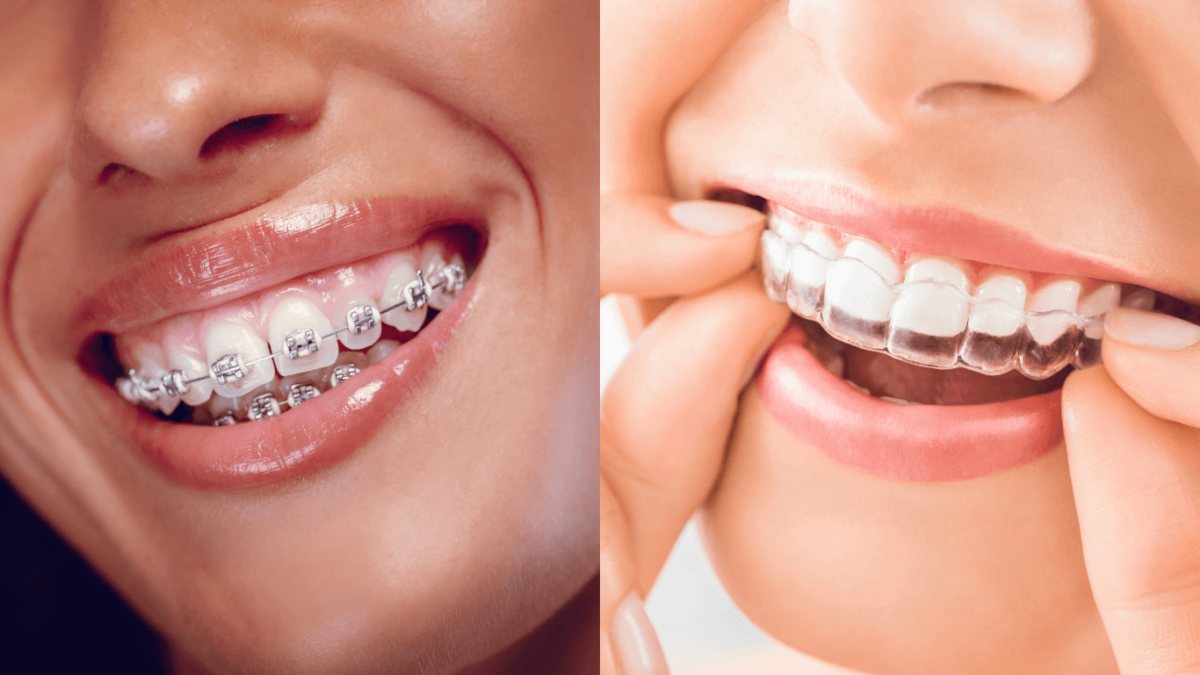Braces vs. Invisalign® | Which Orthodontic Treatment is Right for You?

When it comes to orthodontic treatment, the debate between braces and Invisalign® is a common one among patients seeking a straighter smile. Both methods offer effective solutions for correcting dental misalignments, but they come with distinct features, benefits, and limitations. This article delves into a comprehensive comparison of braces and Invisalign®, covering crucial aspects such as treatment duration, aesthetics, comfort, process, cost, and effectiveness for various dental conditions.
Treatment Duration
Braces: Traditional metal braces typically require a longer treatment time, ranging from 18 months to 3 years, depending on the complexity of the case. The continuous wear, 24/7, contributes to their effectiveness in handling severe misalignments and bite issues.
Invisalign®: Invisalign®, known for its clear aligners, often boasts shorter treatment times, averaging 12 to 18 months. However, this can vary widely depending on the patient’s compliance with wearing the aligners for the recommended 20-22 hours per day and the complexity of their dental issues.
Aesthetics
Braces: The visibility of metal braces is one of their most notable drawbacks. However, advancements have led to more aesthetically pleasing options, such as ceramic braces, which blend in better with the natural color of the teeth but can still be noticeable.
Invisalign®: Invisalign®’s clear aligners are virtually invisible, making them a preferred choice for adults and teens concerned about the appearance of traditional braces. The discreet nature of Invisalign® allows for orthodontic treatment without the aesthetic impact of metal brackets and wires.
Comfort
Braces: Braces can cause discomfort, especially after adjustments, and the brackets may irritate the inner cheeks and lips. Dietary restrictions are also necessary to avoid damaging the braces, which can be an inconvenience.
Invisalign®: The smooth, plastic aligners of Invisalign® are generally considered more comfortable than braces, with no sharp edges or tightening required. The removability of Invisalign® aligners also means there are no food restrictions, contributing to a more comfortable treatment experience overall.
Process
Braces:
- Initial Consultation: The orthodontic treatment with braces begins with a comprehensive evaluation, including X-rays and dental impressions, to assess the patient’s orthodontic needs.
- Installation: During the installation appointment, brackets are bonded to the front of each tooth, and then archwires are attached to the brackets using tiny elastics known as ligatures. The process can take 1-2 hours.
- Adjustment Appointments: Patients with braces must visit their orthodontist every 4-6 weeks for adjustments. During these visits, the orthodontist tightens the archwires and may replace the ligatures. These adjustments gradually move the teeth into the desired position.
- Ongoing Care: Patients must adhere to specific care instructions, including dietary restrictions to avoid damaging the braces and a meticulous oral hygiene routine to prevent tooth decay and gum disease around the brackets.
- Removal and Retention: Once the treatment goals are achieved, the braces are removed—a process that is relatively quick and painless. Most patients will need to wear a retainer to maintain the new position of their teeth.
Invisalign®:
- Initial Consultation: Similar to braces, the Invisalign® process starts with a detailed assessment of the patient’s teeth, using digital scans to create a 3D model of the mouth.
- Custom Treatment Plan: Using the 3D model, the orthodontist devises a personalized treatment plan, which includes a virtual representation of the teeth’s movement and the final outcome. This plan determines the number of aligners required for the treatment.
- Receiving Aligners: The patient receives a series of custom-made, clear aligners, each designed to be worn for about two weeks before switching to the next in the series. The aligners gently shift the teeth into place according to the treatment plan.
- Regular Check-ups: While check-ups are less frequent with Invisalign® than with braces, patients still need to visit their orthodontist every 6-8 weeks to monitor progress and receive new sets of aligners.
- Maintenance and Aftercare: One of the significant advantages of Invisalign® is the lack of dietary restrictions, as the aligners are removed when eating. However, patients must be diligent about wearing the aligners for the recommended 20-22 hours per day and maintaining good oral hygiene. Like braces, wearing a retainer post-treatment is crucial to maintaining the results.
Cost
Braces: The cost of braces can vary widely but is generally in the range of $2,500 to $7,500 in the United States. The price can be influenced by the treatment’s complexity, the type of braces chosen, and the geographic location.
Invisalign®: Invisalign® tends to be more expensive than traditional braces, with costs ranging from $3,500 to $8,000. The higher price point reflects the custom manufacturing of the aligners and the technology used in the treatment planning process.
Effectiveness for Various Dental Conditions
Braces: Braces are highly effective for treating a wide range of orthodontic issues, including severe crowding, spacing, and complex bite problems. Their fixed nature allows for more control over tooth movement, making them suitable for complicated cases.
Invisalign®: Invisalign® is most effective for mild to moderate dental misalignments and bite issues. While significant advancements have been made in the technology, allowing it to treat a broader range of cases than when it was first introduced, there are still limitations to what Invisalign® can achieve, especially for more complex orthodontic needs.
The choice between braces and Invisalign® should be made based on a thorough evaluation of your specific dental needs, lifestyle preferences, and budget. Braces offer a time-tested solution for a wide range of orthodontic issues, including complex cases, but their visibility and comfort level are common concerns. Invisalign®, on the other hand, provides a less noticeable and more comfortable alternative, ideal for those with mild to moderate alignment issues who prioritize aesthetics.
Consulting with an orthodontist is crucial to determine the most suitable option for your situation. They can provide a personalized assessment that considers the severity of your dental conditions, your lifestyle, and your treatment goals. Whether you choose braces or Invisalign®, the journey to a straighter smile is a commitment to improving your oral health and confidence.




